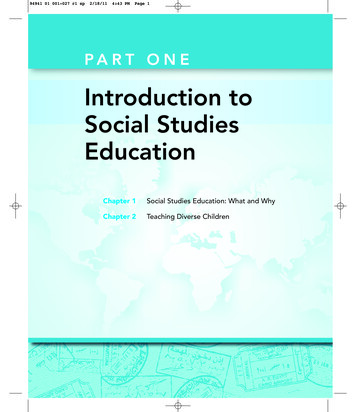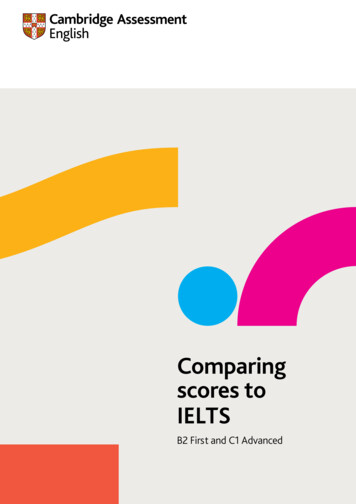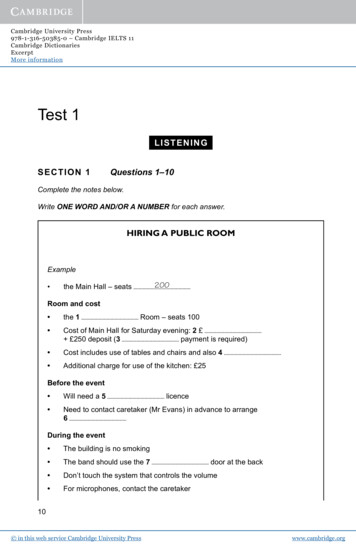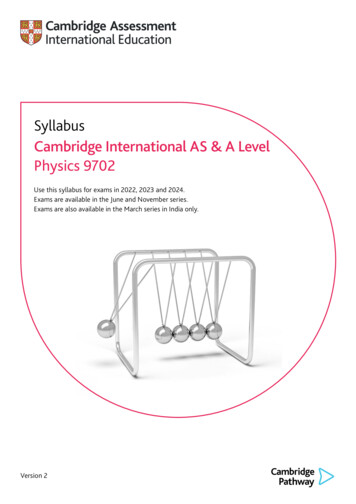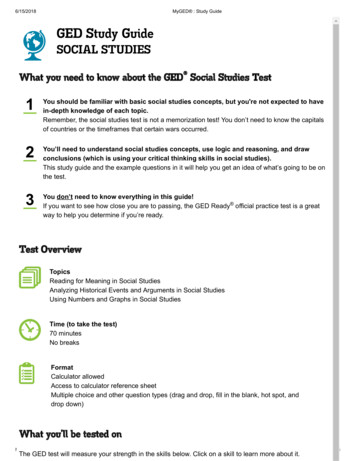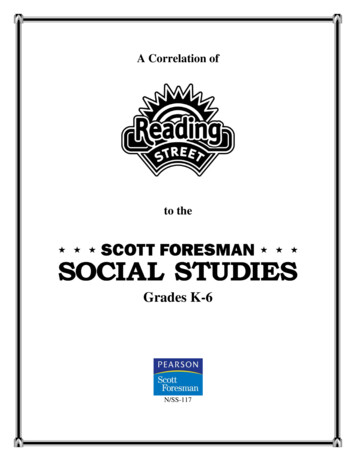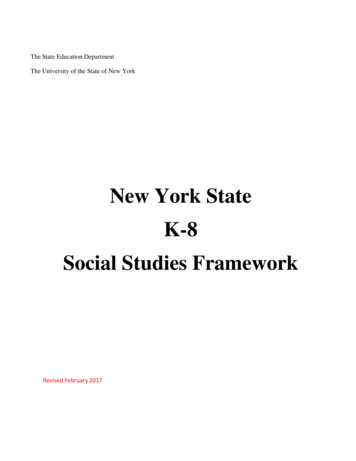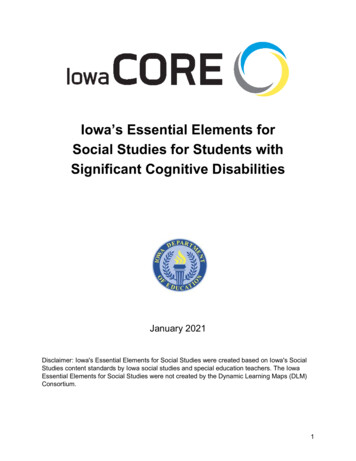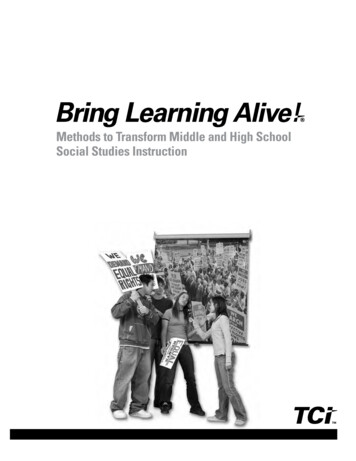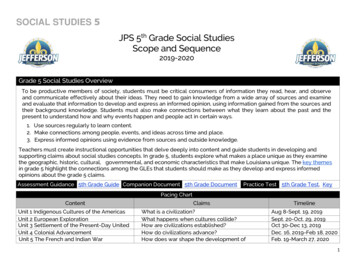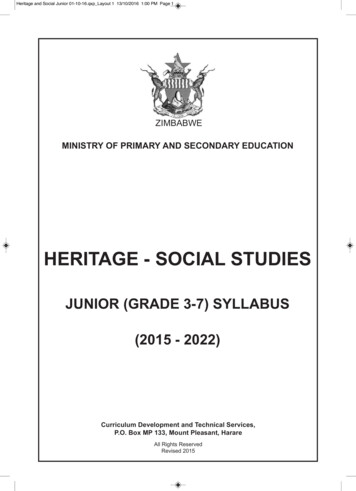
Transcription
Heritage and Social Junior 01-10-16.qxp Layout 1 13/10/2016 1:00 PM Page 1ZIMBABWEMInISTRY Of PRIMARY AnD SECOnDARY EDUCATIOnHERITAGE - SOCIAL STUDIESjUnIOR (GRADE 3-7) SYLLABUS(2015 - 2022)Curriculum Development and Technical Services,P.O. Box MP 133, Mount Pleasant, HarareAll Rights ReservedRevised 2015
Heritage and Social Junior 01-10-16.qxp Layout 1 13/10/2016 1:00 PM Page iHeritage – Social Studies Junior (Grade 3 - 7) SyllabusACKNOWLEDGEMENTSThe Ministry of Primary and Secondary Education wishes to acknowledge the followingfor their valued contribution in the production of this syllabus:l The National Primary Heritage-Social Studies Syllabus Panel for their professionaland technical inputl Representatives from universities, technical colleges, teachers’ colleges, church organisations, book publishers and former educationistsl The Zimbabwe Schools Examinations Council for their contribution on assessmentl UNICEFl UNESCOi
Heritage and Social Junior 01-10-16.qxp Layout 1 13/10/2016 1:00 PM Page iiHeritage – Social Studies Junior (Grade 3 - 7) SyllabusTABLE OF CONTENTSAcknowledgements .i1.0PREAMBLE.11.1Introduction .11.4Assumptions .11.21.32.03.04.05.06.07.09.01.5Rationale.1Summary of Content.1Cross-Cutting Themes.1PRESENTATION OF THE SYLLABUS.1AIMS .2SYLLABUS OBJECTIVES.2METHODOLOGY AND TIME ALLOCATION .2Methodology and Time Allocation .2TOPICS.3SCOPE AND SEQUENCE.4Assessment.68ABBREVIATIONS AND ACRONYMS .74ii
Heritage and Social Junior 01-10-16.qxp Layout 1 13/10/2016 1:00 PM Page 1Heritage – Social Studies Junior (Grade 3 - 7) Syllabus1.0 PREAMBLE1.1 IntroductionThe Heritage-Social Studies syllabus covers Infantand Junior school cycles in primary education. Thesyllabus covers the social history of the people ofZimbabwe, cultural interdependence, local cultures,heritage values and religious practices.The focus of the syllabus is on facilitating thelearner to become a responsible member of his /her family and of Zimbabwe. It has a thrust onZimbabwean identity, norms and values through theinclusion of aspects of heritage studies, thusupholding the spirit of Unhu/Ubuntu/Vumunhu(societal norms and values). It is envisaged that thesyllabus will produce learners who are patriotic,diligent and prepared for diverse vocation andcreative businesses.1.2 RationaleHeritage-Social Studies embraces the Zimbabweanconstitution, patriotism, national identity, nationalsymbols and factors of production such as land,capital, labour and enterprise. It also encompassesthe history, traditions and social qualities which areconsidered an important part of Zimbabwe’s image.Social Studies is the study of people and theirrelationship with the environment. Heritage-SocialStudies moulds the human character and is thefoundation of Unhu/Ubuntu/Vumunhu. It developsa spirit of national consciousness and patriotismthrough interest and involvement in national affairs,conservation and ownership of natural heritage. Itdevelops in the learner, skills of critical thinking,problem solving, leadership and self-esteem,Information and Communication Technology (ICT)and resources management leading to social andeconomic development.1.3 Summary of ContentThe Heritage-Social Studies syllabus’ main thrustis upholding and sustaining:l Unhu/Ubuntu/Vumunhu (societal norms andvalues)l Family, relationships and preservation of ournational heritagel Collaboration with others to improve thelearners’ societyl PatriotismIt instils problem solving, critical thinking skills,leadership, communication, enterprise andtechnological skills.1.4 AssumptionsIt is assumed that the learners;l belong to a social familyl interact with their peersl know some national symbols and heritagellllsitesunderstand and accept their cultural diversitycan communicate and think logicallyappreciate the relevance of their learningengage in project work, co-operative work andself-assessment activities1.5 Cross-Cutting ThemesThe following cross cutting or emerging issues helpthe learner to acquire competencies for lifelonglearning.l Gender equityl Family unityl Child Protection from abuse and diseasessuch as AIDSl Heritage Studiesl Environmental Issuesl Financial literacyl Disaster Risk Managementl Children’s Rights and Responsibilities2.0 PRESENTATION OF THESYLLABUSThe Heritage-Social Studies Syllabus is presentedin two documents as follows:1
Heritage and Social Junior 01-10-16.qxp Layout 1 13/10/2016 1:00 PM Page 2Heritage – Social Studies Junior (Grade 3 - 7) Syllabusl Infant (ECD - Grade 2)l Junior (Grade 3 –7)The two documents carry the same informationfrom the preamble up to the Scope and SequenceChartAll grades have the same topics that aredevelopmental in nature.3.0 AIMSThe aims of the syllabus are to enable the child to:l appreciate and love Zimbabwe and itsChimurenga/Umvukela Liberation war heroesand heroinesl develop an appreciation of national heritage,sovereignty, governance, national symbols andeventsl understand and appreciate Zimbabwe’spre-colonial, colonial and post-colonial historyl develop an understanding of Zimbabweancultural institutions and practices such asmarriages, inheritance systems,spiritual values and usage of artefactsl develop a spirit of national consciousness,identity and patriotism through involvement innational functionsl appreciate and sustain Unhu/Ubuntu/Vumunhuthrough interaction with family, community andsociety at largel appreciate the value and dignity of work,recreation and the need for participation innational developmentl appreciate the need for equal opportunities forall and sensitivity to the needs of thedisadvantaged and vulnerable groups4.0 SYLLABUS OBJECTIVESBy the end of the Heritage-Social Studies PrimarySchool Syllabus, learners should be able to:l identify with national symbols such as theNational Flag, National School Pledge,Anthem, Monuments and Heritage sitesl explain the significance of public holidays andother national eventsl demonstrate ways of showing respect for selfand othersl exhibit norms, values and appropriateresponsible behaviourl differentiate between new and old means oftransport, Information and CommunicationTechnology (ICT)l explain how modes of transport and ICTfacilitate communication among people andcountriesl justify the importance of work and leisurel explain key events and importance of the Firstand Second Chimurenga/Umvukela liberationstrugglel compare the practices of their own communityculture and that of othersl identify appropriate shelter for humans andanimalsl explain the need of equal opportunities for allcitizens of Zimbabwel identify the global environmental issues thataffect livelihoodsl describe the production and marketing ofgoods and services5.0 METHODOLOGY AND TIMEALLOCATION5.1 MethodologyA spiral approach should be adopted,beginning with the learner’s immediateenvironment, broadening to an exploration ofhis/her wider community and finally extendingto the wider world. Learners need to develop2
Heritage and Social Junior 01-10-16.qxp Layout 1 13/10/2016 1:00 PM Page 3Heritage – Social Studies Junior (Grade 3 - 7) Syllabusappropriatevalue systems through participating in plannedactivities. Effective teaching and learning inHeritage-Social Studies depends upon the useof participatory methods. These include thefollowing:(a)discussion(c)song and dance(b)drama, role-play and simulation(d)case studies(f)gallery ures wheelmiminge-learninggroup workquestion and answerIndividual Early Learning Programme(IELP)gamesFor adequate coverage of the syllabus, the followingallocation is advised.ECD: 2 periods of 20 minutes per weekGrade 3 to 7: 4 periods of 30 minutes per weekGrade 1 and 2 : 3 periods of 30 minutes per weekFor the successful implementation of the HeritageSocial Studies Syllabus the following activities arerecommended:l Educational tours – at least once per yearl School festivals Day – once a yearl Heritage Culture Day – once a yearNOTE: These events can be organised at school, district,provincial and national levels.6.0 TOPICSlllllllIdentity: Family History and Local HeritageCultural HeritageNational History, Sovereignty and GovernanceEntitlements/Rights and ResponsibilitiesShelterSocial Services and VolunteerismNatural Heritage: Production, Distribution andConsumption of Goods and Servicesl Transport and Communicationl Work and Leisurel Global Issues3
4 Friendship Relationships Family ceremonies and rituals Children’s games Rites of passage forboys and girls Courtship Indigenous ways ofgetting married andceremonies Marriage: civil andcustomary Children’s games Types of family:- nuclear- monogamous- polygamous- child headed- one parent Family and surroundingcommunity Indigenous communitygatherings and events Human migration Conflict management at family ,school and community levels Languages and cultures inZimbabwe National monumentsGRADE 5 Family ceremonies andrituals:-birth-adolescence-marriage-death- after burial Customs of differentcultural groups Indigenous medicines andrelated cultural practices Children’s gamesTOPIC 2:HERITAGETOPIC2:CULTURALCULTURALHERITAGE Roles and status of familymembers Family aspirations Family gatherings Indigenous processing toolssuch as duri/umgigo,guyo/imbokodo Local shrines and monuments Familygenealogies Familynames andtotems Purpose ofthe totemsystem Local heroesand heroines Indigenoushunting tools Indigenousreligiouspractices GRADE 4 GRADE 3 TOPIC1: IDENTITY: FAMILY HISTORY AND LOCAL HERITAGE 7.0 SCOPE AND SEQUENCE Courtship practices ofdifferent cultural groups Heirship within the family Age of consent to sex andmarriage Clans of Zimbabwe Cultural values of motherhoodin the pre-colonial era Cultural values of fatherhoodin the pre-colonial era Significance of customs,beliefs, folklore, games, songsand dances Indigenous languages andcultures in Zimbabwe Indigenous governance Indigenous heritage resourcesGRADE6 Healthy boy-girl relationships Effects of age on marriage andpopulation growth Child bearing Marital relationships Conflict management Different languages andcultures of Zimbabwe Custodians of culture Preservation of heritage sitesGRADE 7Heritage and Social Junior 01-10-16.qxp Layout 1 13/10/2016 1:00 PM Page 4Heritage – Social Studies Junior (Grade 3 - 7) Syllabus
Symbols of unityGRADE 3 National events/celebrationsGRADE 4 The early people ofZimbabwe: TheKhoisan and Bantu Contribution of theearly people to theZimbabwean heritage The need for rules andlaws Observing the laws: therole of individuals,community, police andthe courts Development ofindigenous laws:- village court- headman’s court- chief’s court National School pledgeGRADE 5 The pre-colonial kingdoms:Rozvi, Mutapa and Ndebele Effects of first contact withEuropeans:-missionaries-hunters and mineralprospectors Local Government:- rural- urban-metropolitan provinces Roles of village head,headman, chief and councillorGRADE6 Systems of Governance:-egalitarian-autocracy-democracy Structures and functions ofCentral Government Colonisation of Zimbabwe First Chimurenga/ Umvukela Second Chimurenga/Umvukela and sovereignty National symbols andcelebrations National School pledgeTOPIC 3: NATIONAL HISTORY, SOVEREIGNTY AND GOVERNANCEGRADE 7 Independence and selfgovernance The Land Reform Programme National School pledge Zimbabwe as a member of otherregional and internationalorganisationsHeritage and Social Junior 01-10-16.qxp Layout 1 13/10/2016 1:00 PM Page 5Heritage – Social Studies Junior (Grade 3 - 7) Syllabus5
6GRADE 3 Functions of buildings and othertypes of shelterShelter and heritage sitesTOPIC5: 5:SHELTERTOPICSHELTERGRADE 3 Entitlements/ Rights andresponsibilities of children Gender equity in thecommunity Division of labour at homeand school Indigenous cultural beliefsand taboos Reporting abuseGRADE 7 Problems and solutions toshortages of shelter Factors that influenceshelter siting and design Ways of acquiringaccommodationGRADE 7 Elections Ownership of property Inheritance Indigenous institutions anddomestic legislation on genderequity Consumer rightsGRADE 6 Development ofsettlements in Zimbabwe Siting of shelter in urbanand rural areas Disaster and riskmanagementGRADE6 Law making process inZimbabwe Gender stereotypes Gender equity in the workplaceGRADE 5 Shelter and heritage sites Health and safety inshelter designsSpecial buildings anddesigns for disaster proneareasGRADE 5 The Rights of the child Citizenship Rights and responsibilitiesof a citizen Abuse of children, women,men and thedisadvantaged Gender based protection The role of the police andjudiciaryGRADE 4 Indigenous forms ofshelter Shelter in other countries Materials used to makeshelter Types of shelter accordingto geographical areasGRADE 4 Children’s entitlements/rights andresponsibilities Child protection Substance abuse Rules and laws thatprotect children fromabuseTOPIC 4: ENTITLEMENTS/RIGHTS AND RESPONSIBILITIESHeritage and Social Junior 01-10-16.qxp Layout 1 13/10/2016 1:00 PM Page 6Heritage – Social Studies Junior (Grade 3 - 7) Syllabus
GRADE 4 Local social serviceproviders Functions of localsocial serviceprovidersGRADE 5 Prominent people andorganisations involved involuntary work, in the pastand present at local andnational level Local voluntaryorganisations thatempower the vulnerableand disadvantagedGRADE6 Provision of social servicesin Zimbabwe Government departmentsand institutions Participation in voluntaryworkGRADE 7 Prominent people involved in voluntarywork in the past and present Participation in voluntary work Voluntary and humanitarianorganisations in the countryGRADE 3 Natural resources Food and cash crops Forms of wealthGRADE 4 Conservation ofnatural resources Indigenous methodsof manufacturinggoods Types of industries Barter tradeGRADE 5 Productive sectors:- agriculture- mining- fishing Income, expenditure andbudgeting BankingGRADE6 Land as a basic means ofproduction Redistribution of land Manufacturing and distribution ofgoodsGRADE 7 National strategic reserves Storage and marketing of goods (importsand exports) Indigenous and contemporary ways ofpreserving food Enterprise skills/ Self-reliance andemployment creationTOPIC 7: NATURAL HERITAGE: PRODUCTION,TOPIC 7: NATURALHERITAGE:PRODUCTION,DISTRIBUTIONAND CONSUMPTIONDISTRIBUTIONANDCONSUMPTIONOFGOODS ANDSERVICESOF GOODS AND SERVICESGRADE 3 Government as a socialservice provider The needy in the society andaccess to informationTOPIC 6: SOCIAL SERVICES AND VOLUNTEERISMHeritage and Social Junior 01-10-16.qxp Layout 1 13/10/2016 1:00 PM Page 7Heritage – Social Studies Junior (Grade 3 - 7) Syllabus7
8GRADE 3 Different occupations in thecommunity Leisure facilities in thecommunityGRADE 4 Reasons for work Sport and arts asforms of work Visual andperforming artsas forms ofleisure Responsible useof leisure timeTOPIC 9: WORK AND LEISURE(Takeofnoteof safetywork andduringleisuretime)(Take notesafetyatatworkandduringleisuretime)GRADE6 Importance of transport,communication and ICTs Modes and forms oftransport andcommunication Transport andcommunication links withother countriesGRADE6 Enterprise skills Tourism in Zimbabwe Sport, Arts and Cultural activities Responsibility at work and duringleisure time Occupational safetyGRADE 5 Development of transportand communicationsystems Transportation of goods byrail, road, air and sea Road ports, Seaports andairports linked toZimbabweResponsible use ofcommunication systemsGRADE 5 Employmentcreation inZimbabwe Work and leisure inthe past and present Responsible use ofleisure timeGRADE 4 The increasing need fortransport Major roads and rails inZimbabwe Public and private forms oftransport andcommunication Road safetyTOPIC 9: WORK AND LEISUREGRADE 3 Relationship betweenpopulation and transportsystems The need for communication Modern forms ofcommunicationTOPIC 8: TRANSPORT AND COMMUNICATIONGRADE 7 Human capital development inZimbabwe Self-reliance and employmentcreation Protection of workers’ rights Responsibility at work and duringleisure time Tourism in SADC and othercountriesGRADE 7 Factors that influence choice ofmode of transport andcommunication Importance of up-to-date mapsand charts for travellingpurposes Hazards and disasters in thetransport and communicationindustryManagement of disasters in thetransport industryHeritage and Social Junior 01-10-16.qxp Layout 1 13/10/2016 1:00 PM Page 8Heritage – Social Studies Junior (Grade 3 - 7) Syllabus
GRADE 3 Afforestation DroughtGRADE 4 EnvironmentalconservationTOPIC 10: GLOBAL ISSUESGRADE 5 Poverty HIV and AIDS:- causes and mitigatorymeasures Pollution:- causes and effects ofpollution on theenvironmentGRADE6 Disasters and disastermanagement Information andCommunicationTechnology (ICT)developmentGRADE 7 Environmental issues:- Desertification:- Causes, effects and solutions Pollution:-Causes, effects and solutionsHeritage and Social Junior 01-10-16.qxp Layout 1 13/10/2016 1:00 PM Page 9Heritage – Social Studies Junior (Grade 3 - 7) Syllabus9
10 LOCAL HEROES ANDHEROINESINDIGENOUS HUNTINGTOOLS identify indigenous huntingtoolsdescribe how the indigenoushunting tools are madeexplain the use of indigenoushunting toolsoutline what makes one ahero or heroineidentify local heroes andheroinesexplain the importance of thetotem systemidentify family names andtotemsstate common totems in theircommunitiesrecite praise poems of theirtotemsLEARNING OBJECTIVESLearners should be able to: trace the origins of the family explain the importance offamily genealogiesPURPOSE OF THETOTEM SYSTEMFAMILY NAMES ANDTOTEMSFAMILY GENEALOGIESKEY CONCEPTS Indigenous huntingtools Uses and storage of theindigenous huntingtools Attributes of ahero/heroine Family and communityheroes and heroines Importance of totems:-identity-marriage-preservation ofnatural resources-social interaction Family names andtotems Family tree Genealogies anddescendants- Father’s ancestors- Mother’s ancestorsUNIT CONTENTTOPIC 1: IDENTITY: FAMILY HISTORY AND LOCAL HERITAGE8.0 COMPETENCY MATRIXGRADE 3 Explaining the terms heroes andheroinesNaming family and communityheroes/heroinesDiscussing their contributionsListing hunting toolsMaking models of hunting toolsMiming using hunting toolsDiscussing the importance of totemsin marriagesTabulating totems and their sacredanimals/objectsDrawing and labelling their owntotem symbolsMatching family names and theirtotemsGrouping members of the classaccording to their totemsDramatising praise poems of theirtotemsSUGGESTED LEARNING ACTIVITIESAND NOTES Discussing origins of their families Drawing family tree up to their greatgrand fathers Researching on the importance offamily genealogies ICT toolsPicturesResource personRelated literatureIndigenous hunting toolsICT toolsResource personPicturesRelated literatureICT toolsPictures and drawingsResource personRelated literatureSUGGESTED LEARNINGRESOURCES ICT Tools Resource person Stories Illustrations of familytrees Pictures Related literature ICT tools Resource person Related literatureHeritage and Social Junior 01-10-16.qxp Layout 1 13/10/2016 1:00 PM Page 10Heritage – Social Studies Junior (Grade 3 - 7) Syllabus
INDIGENOUS RELIGIOUSPRACTICESKEY CONCEPTSLEARNING OBJECTIVESLearners should be able to: identify the variousindigenous religious practices describe the commonindigenous religious practicesin their communities Religious practices andprocesses:- at funerals- after funerals- during marriages Rites of passage InheritanceUNIT CONTENTSUGGESTED LEARNING ACTIVITIESAND NOTES Dramatising various indigenousreligious processes Telling story on various indigenousreligious practices Researching on indigenous religiouspractices Singing songs Discussing various religiousceremoniesSUGGESTED LEARNINGRESOURCES ICT tools Resource person Pictures Related literatureHeritage and Social Junior 01-10-16.qxp Layout 1 13/10/2016 1:00 PM Page 11Heritage – Social Studies Junior (Grade 3 - 7) Syllabus11
12 FAMILY CEREMONIESAND RITUALSCHILDREN’S GAMES state children’s games thatinstil norms and valuesplay some games that teachnorms and valuesname different members ofthe familyexplain how members of thefamily relate to each otheridentify family ceremoniesand ritualsdescribe processes of somefamily rituals FAMILY RELATIONSFRIENDSHIPLEARNINGOBJECTIVESLearners should be able to: justify the need for friends state examples of peerfriendshipKEY CONCEPTSTOPIC 2: CULTURAL HERITAGE Family ceremonies andrituals:- birth- funerals- marriagesChildren’s games:- indigenous- modernRelationships within thefamilyFamily members rolesNeed for friendsFriends for differentoccasions/situations/purposesQualities of a good friendUNIT CONTENT Listing gamesDiscussing the listed games inrelation to norms and valuesPlaying some gamesSUGGESTED LEARNINGACTIVITIES AND NOTES Explaining the need for friends Suggesting different ways ofmaking friends Listing qualities of a good friend Singing songs about makingfriend Listing members of the family Drawing family trees of familymembers Role playing family relationships Discussing some family rituals Listing some family rituals Performing some family rituals ICT toolsGames cardsRelated literatureResource personICT toolsArtefactsResource personRelated literatureSUGGESTED LEARNINGRESOURCES ICT tools Stories Music Folktales Resource person Related literature ICT tools Drama Related literatureHeritage and Social Junior 01-10-16.qxp Layout 1 13/10/2016 1:00 PM Page 12Heritage – Social Studies Junior (Grade 3 - 7) Syllabus
SYMBOLS OF UNITYNATIONAL EVENTS/CELEBRATIONSKEY CONCEPTS identify symbols of nationalunityexplain the national schoolpledgeLEARNING OBJECTIVESLearners should be able to: list some national events discuss the significance ofsome national events National symbols:-Flag-National anthem-Coat – of - arms-National emblem-National schoolpledgeNational events- Independencecelebrations Day- Heroes Daycelebrations- Defence Forces DayUNIT CONTENT Listing symbols of national unityDrawing and colouring some of thesymbols of national unitySinging the national anthemReciting of the national schoolpledgeDiscussing the national schoolpledgeSUGGESTED LEARNING ACTIVITIESAND NOTES Identifying some national events Participating in some nationalevents and celebrationsTOPIC 3: NATIONAL HISTORY, SOVEREIGNTY AND GOVERNANCE ICT toolsThe National flagPicturesNational symbolsRelated literatureSUGGESTED LEARNINGRESOURCES ICT tools Calendars showingnational events Pictures Related literatureHeritage and Social Junior 01-10-16.qxp Layout 1 13/10/2016 1:00 PM Page 13Heritage – Social Studies Junior (Grade 3 - 7) Syllabus13
14REPORTING ABUSEINDIGENOUSCULTURAL BELIEFSAND TABOOS DIVISION OF LABOURAT HOME AND SCHOOL identify various forms ofabusedescribe various ways ofreporting abusestate the duties of differentpeople at home and schoolexplain the importance of thedivision of labouroutline advantages anddisadvantages of division oflabouridentify cultural beliefs andtaboos which upholdentitlements/rights andresponsibilities of childrenidentify cultural beliefs andtaboos which violateentitlements/rights andresponsibilities of childrendescribe gender equity inthe communityLEARNING OBJECTIVESLearners should be able to: state children’sentitlements/rights andresponsibilitiesGENDER EQUITY IN THECOMMUNITYENTITLEMENTS/RIGHTS ANDRESPONSIBILITIES OFCHILDRENKEY CONCEPTS Reporting proceduressuch as childline andchild protectioncommitteeCultural beliefs andtaboosDivision of labour athome and at schoolAdvantages anddisadvantages ofdivision of labourGender equity in thecommunityChildren’sentitlements/rights andresponsibilitiesUNIT CONTENT Discussing various forms ofabuseExplaining various ways ofreporting abuseDiscussing some cultural beliefsand taboosClassifying some cultural beliefsand taboosDescribing division of labour athome and at schoolDiscussing advantages anddisadvantages of division oflabourSUGGESTED LEARNINGACTIVITIES AND NOTES Listing entitlements/ rights andresponsibilities of children Explaining children’sentitlements/rights andresponsibilities Demonstrating equity in treatingboys and girls Role playing equitable duties ofgirls and boysTOPIC 4: ENTITLEMENTS/RIGHTS AND RESPONSIBILITIES ICT toolsResource personPicturesPamphletsRelated literatureICT toolsResource personRelated literatureICT toolsPicturesArticles from newspapersRelated literatureSUGGESTED LEARNINGRESOURCES ICT tools Constitution of Zimbabwe African Charter UN Rights Charter Related literature ICT tools Resource person Pictures Related literatureHeritage and Social Junior 01-10-16.qxp Layout 1 13/10/2016 1:00 PM Page 14Heritage – Social Studies Junior (Grade 3 - 7) Syllabus
identify heritage sites inZimbabwedescribe heritage sites inZimbabweLEARNING OBJECTIVESLearners should be able to: list functions of differentbuildings and other types ofshelter Shelter and heritagesites:-Great Zimbabwe-Matopo Hills-GonakudzingwaFunctions of buildingsand other types ofshelterUNIT CONTENTTHE NEEDY IN THESOCIETY AND ACCESSTO INFORMATION GOVERNMENT AS ASOCIAL SERVICEPROVIDERidentify the needy in thesocietyexplain how the needy canaccess information to gethelpLEARNING OBJECTIVESLearners should be able to: describe social servicesprovided by the government state the governmentinstitutions from which socialservices can be obtainedKEY CONCEPTSTOPIC 6: SOCIAL SERVICES AND VOLUNTEERISM The needy in society:- orphans- economicallydisadvantaged- elderlyAccess to informationGovernment ortUNIT CONTENTTOPIC 6: SOCIAL SERVICES AND VOLUNTEERISMSHELTER ANDHERITAGE SITESFUNCTIONS OFBUILDINGS AND OTHERTYPES OF SHELTERKEY CONCEPTSTOPIC 5: SHELTERDiscussing heritage sites inZimbabweListing heritage sitesConducting educational tours ICT toolsPamphletsNewspapersRelated literatureSUGGESTED LEARNINGRESOURCES ICT tools Resource person Related literatureSUGGESTED LEARNINGRESOURCES ICT tools Pictures Buildings and otherstructures Related literature ICT tools Pictures Artefacts Related literatureSUGGESTED LEARNING ACTIVITIESAND NOTES Stating social services provided bythe government Identifying government institutionswhere social services are obtained Discussing how government extendsvarious forms of servicesNOTE: Teacher to note role ofgovernment in both policy formulation andservice provision Listing the vulnerable in society Classifying the needy in society Visiting and helping the needy Discussing information disseminationfor the needy SUGGESTED LEARNINGACTIVITIES AND NOTES Naming different types of shelter Describing functions of variousshelter Matching shelter and its functionsHeritage and Social Junior 01-10-16.qxp Layout 1 13/10/2016 1:00 PM Page 15Heritage – Social Studies Junior (Grade 3 - 7) Syllabus15
16 FORMS OF WEALTHidentify various forms ofwealthlist food and cash cropsdistinguish between food andcash cropsLEARNING OBJECTIVESLearners should be able to: identify the natural resourcesin Zimbabwe state the benefits of naturalresources in the localityFOOD AND CASHCROPSNATURAL RESOURCESKEY CONCEPTS Forms of ral mals-water-air-sunlightFood cropsCash cropsUNIT CONTENT Listing forms of wealthDiscussing forms of wealthNaming food cropsNaming cash cropsComparing food and cash cropsSUGGESTED LEARNING ACTIVITIESAND NOTES Listing natural resources Discussing uses of naturalresources Conducting field trips to observenatural resources ICT toolsFood cropsCash cropsPicturesRelated literatureICT toolsNatural resourcesRelated literature21SUGGESTED LEARNINGRESOURCES ICT tools Natural resources in thecommunity Related literatureTOPIC 7: NATURAL HERITAGE: PRODUCTION, DISTRIBUTION AND CONSUMPTIONOF GOODS AND SERVICESHeritage and Social Junior 01-10-16.qxp Layout 1 13/10/2016 1:00 PM Page 16Heritage – Social Studies Junior (Grade 3 - 7) Syllabus
MODERN FORMS OFCOMMUNICATIONRELATIONSHIPBETWEEN POPULATIONAND TRANSPORTSYSTEMTHE NEED FORCOMMUNICATIONKEY CONCEPTS describe forms of moderncommunication discuss the need forcommunicationsuggest appropriate meansof communication Modern forms ofcommunication suchas telegram,telephone, fax, e-mail,letter, social medialike whatsapp,facebook, twitterNeed forc
Heritage –Social Studies Junior (Grade 3 - 7) Syllabus 1.0 PREAMBLE 1.1 Introduction The Heritage-Social Studies syllabus covers Infant and Junior school cycles in primary education. The syllabus covers the social history of the people of Zimbabwe, cultural interdependence,

